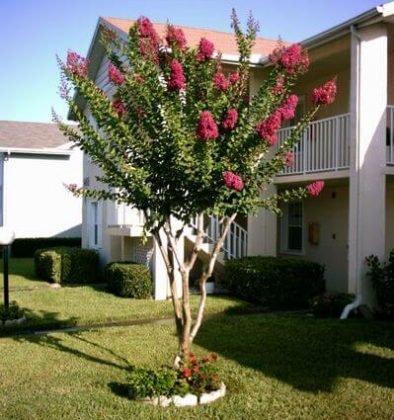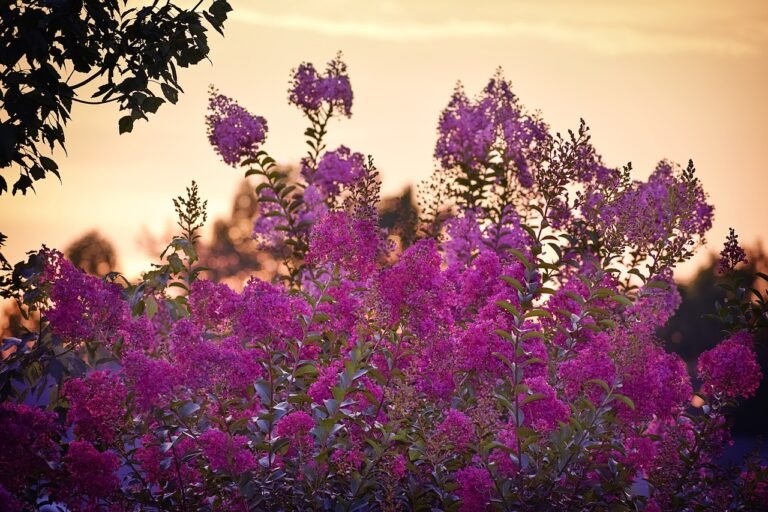Crape Myrtle Tree Care

The crape myrtle tree is great for Florida’s climate throughout the north, central, and southern regions. Often used in landscapes as a beautiful tree with lots of colors when blooming. Proper crape myrtle tree care is needed for good health and growth. Flowering begins in June and continues through the summer on into early fall.
Clusters of buds on the tips of branches produce hundreds of 1-2 inch blooming flowers. Crape myrtle tree types consist of the colors, red, white, lavender or pink, and purple. Leaves are 1-4 inches long and turn red in spring, and dark green in summer. In northern Florida trees, the leaves will turn yellow, orange, and red in the fall.
Tree Placement
The time to plant container-grown crape myrtle trees is during early summer when in active growth. Balled or burlapped crape myrtles should be planted while dormant.
Place in full sun for they do poorly in shaded areas.
Plant in well-drained soil for they don’t like soil that stays wet and soggy and needs good air circulation to avoid problems.
Crape myrtle trees have a low salt tolerance level, so do not plant close to sea walls or seaside locations.
Watering Crape Myrtles
A newly planted tree needs to be watered regularly for the first three weeks, for good root establishment. When established watering every two weeks is sufficient for crape myrtle tree care. When fully mature crape myrtle trees are drought tolerant and can go without watering for a month if there is no rainfall or problems with irrigation.
Fertilizer Crape Myrtle Tree Care
Crape myrtle trees when mature do not need to be fertilized very often. When placed in the middle of lawns they receive nutrients from lawn fertilization. Mature trees in other locations need one application a year in spring. However, newly planted trees require fertilization in the beginning up to three times the first year. Early crape myrtle tree care will help stimulate the growth of young trees.
Crape Myrtle Tree Care For Pests and Problems
Primary pests are powdery mildew and the aphid insect which produces “Black Sooty Mold”. A program of spraying a systemic pesticide and fungicide for crape myrtle tree care can help control problems. Regular inspections will detect any problems early, to avoid spreading. Sprays of insecticidal soaps and horticultural oil will stop aphids on contact.
Aphid insects are pale yellow in color found underneath the leaves and are attracted to new growth. Infested leaves will become distorted and the new growth is stunted. Aphids suck the juices out of stems, and eventually can severely injure the tree. Aphids reproduce quickly and will spread to other trees close by, without immediate insecticidal crape myrtle tree care.
Aphids secrete droplets containing a sugary solution called ” Honey Dew “, which produces ” Black Sooty Mold ” on leaves and stems. It interferes with the leaves from getting sunlight hindering photosynthesis.
Powdery mildew is caused by a fungus and is seen first on new shoots. Then it spreads to the leaves, stems, and flowers. They will also become distorted and stunted by this problem. When severe leaves will drop and buds fail to open. Trees planted in shade and in locations with poor air circulation will have problems with powdery mildew. Also, continuous wetting of leaves from irrigation staying wet and not dry from the sun can cause it to occur.
Pruning a Crape Myrtle Tree
Crape myrtle trees are relatively easy to care for, but they do require some pruning to maintain their health and beauty. Here are some of the reasons why it is important to prune a crape myrtle tree correctly.
- To control the tree’s size and shape. Crape myrtles can grow quite large, so pruning can help to keep them in check. It can also be used to shape the tree into a desired form, such as a pyramid or oval.
- To remove dead, diseased, or damaged branches. This will help to prevent the spread of disease and pests.
- To encourage new growth and flowering. When you prune a crape myrtle, you are stimulating new growth. This new growth will produce more flowers the following year.
- To improve air circulation and reduce the risk of pests and diseases. Proper pruning can help to improve air circulation around the tree, which can help to reduce the risk of pests and diseases.
- To reveal the beautiful bark. As crape myrtle trees mature, they develop a beautiful, mottled bark. Proper pruning can help to reveal this bark.
It is important to note that not all pruning is created equal. If you prune a crape myrtle incorrectly, you can actually damage the tree. The most common mistake is to cut the tree back too hard. This can result in weak branches that are more susceptible to breakage. It can also delay flowering and make the tree more susceptible to pests and diseases.
The best time to prune a crape myrtle is in the spring, before new growth begins. However, you can also prune it in the fall, after the leaves have fallen. Just be sure to avoid pruning in the winter, when the tree is dormant.
If you are not comfortable pruning your crape myrtle yourself, you can always hire a professional arborist. They will be able to prune the tree correctly and help you to achieve the desired results.
Here are some tips for pruning a crape myrtle tree correctly:
- Use sharp, clean pruning shears.
- Cut branches back to a healthy bud or branch union.
- Avoid cutting back too hard.
- Thin out the tree by removing dead, diseased, or damaged branches.
- Prune to the desired shape.
- Dispose of pruned branches properly.
By following these tips, you can prune your crape myrtle tree correctly and help it to thrive for many years to come.
Conclusion
The crape myrtle tree is one of the most common parts of the Florida landscape. Trees can be seen along our roads, highways, and parks. During the summer with loads of blooming colorful flowers, they are attractive and eye-catching. With good crape myrtle tree care, they will offer a beautiful setting for years.
Resources:






